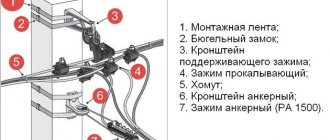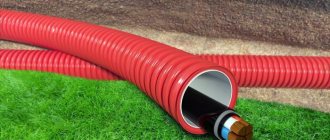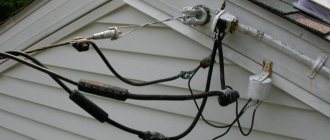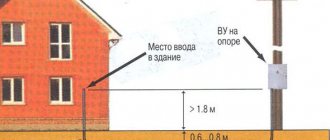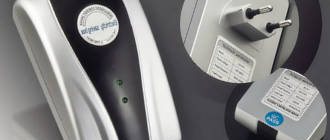To connect a residential building to a power line made with insulated SIP wires, 3 options are most often possible:
- underground cable entry directly from the support
- installation of SIP to the facade of the house by air
- installation of a pipe stand for SIP in the immediate vicinity of the site and the existing overhead line
In the first two cases, you have to place the metering cabinet with the meter and all switching devices directly on the wall of the house.
It is rare that an electrical network company allows metering to be placed indoors, citing the lack of free access to take readings and check the connection diagram. Therefore, if you do not want to spoil your house facade with bulky cabinets, then a SIP pipe stand with a meter is the best option.
You can, of course, place it directly on the power grid company’s pole, but this must be specified in the technical specifications. And in this case, maintenance of power lines on such a support becomes difficult. Moreover, if some electrician accidentally damages your shield with a claw or a manhole while lifting, you will not receive any compensation.
Also, if the pole is located far from the house, there is always a risk of damage to the metering by unauthorized persons. The metal stand will be located on your site, under guard and will not disturb anyone.
Well, the most common option is when the house has not yet been built, there is only a bare plot, and the voltage is already needed for its construction. This is where the pipe stand is the only way to safely connect electricity.
Installation of the pipe stand takes place in several stages:
- assembly and production of the structure itself
- excavation of a hole
- direct installation into the pit and fastening in it
- assembly of a distribution cabinet with a meter and automatic machines
- securing the metering cabinet to an installed rack
- connection to the SIP line
- connecting a residential building from the cabinet
Making a pipe stand
Strictly speaking, the pipe stand today does not have any official technical definition or certification. That's why they make it at whatever cost. The best material for assembling a metal stand is a square pipe 80*80*3. It will ensure sufficient strength of the structure when tensioning the SIP from the support. Although standard technical solutions allow a diameter of at least 40mm.
Some, the base of the rack is made using a screw pile with a diameter of 108mm. They screw it into the ground with pieces of pipes d-40mm and 2-3m long. After which a pipe or square of the required height is inserted inside.
What should the height of the pipe stand be? According to the rules, the minimum distance from the SIP wire to the ground can be at least 2.5 m. That is if he doesn't cross the road. When passing over the road, the clearance increases to 5m!
However, they may not allow you to invent homemade structures of such a height, having written a reasoned refusal stating that you do not have a certified stand for crossing the road. In this case, you need to raise all legal documents and prove that installing additional support across the road is the responsibility of the network organization, and not yours.
Analysis of the provisions of the rules for technological connection (taken from forumhouse.ru) -
But some people accept such accounting without problems and everything is connected. So each case is individual and depends on the local office.
Based on the minimum dimensions above the ground (without crossing the road) and taking into account the depth of 1.5 m, we obtain the optimal height of the pipe stand of 4-5 meters. This can be either a solid version or component parts of more than two meters each.
It is better to choose a composite product, since it is already problematic to bring a 5m long pipe to the site yourself. You will have to hire special transport, and this is an extra expense. The method of joining individual pieces is welding or bolting.
When connecting individual pipes, it is better to choose profiles of different sizes. So that the diameter of the outer upper part fits tightly into the diameter of the inner lower part.
A more complicated option, but more stable and without the use of welding:
- take three pieces of square profile 3 meters each. Minimum dimensions 60*60*3.
- Bury 2 profiles into the ground at a depth of 1.5 m with a distance of 60 mm between them. There is still 1.5m above the ground.
- between two pieces protruding from the ground, place a third one, thereby, as it were, increasing the height of the pipe stand.
- drill the joints of the profiles in two places and tighten the whole thing with bolts or studs.
The final result will look something like this.
The top hole of any pipe stand must be welded. This is done so that moisture does not enter or accumulate inside, which is why the metal will begin to actively rust. The outside of the entire structure is painted. It is better to treat the lower part, which will be in the ground, with bitumen, or if finances allow, find the required diameter and shrink a heat-shrinkable tube. Such a base will never corrode or break over time.
A loop for attaching the SIP tension clamp is welded on the top itself.
If there is no welding, then you can drill a hole d=12-16mm and mount a special hook under the nut.
At a height of 1.7 m from the ground, two crossbars made of steel strip are fixed to support the metering cabinet. Measure the distances between the strips using the holes on the cabinet.
You can, of course, use special factory kits for metal cabinets using bandage tape and do without welding.
But this is if you have the necessary tool (bandage machine) and materials (tape and staples).
Without departing from the standards
If possible, can some types of work be done independently? A specific example: will there be any problems with the electrical networks if you make a pipe stand for the input of electricity yourself? Doing it yourself is allowed, provided that the result obtained fully complies with the technical conditions. This element is made from steel pipe. If it is necessary to enter two wires, then its internal diameter should be 20 mm, and for four wires - 32 mm. To avoid moisture getting into the pipe, its end should be bent down, literally turned in the form of a hook 180 degrees in the opposite direction, this is what a pipe stand should look like for introducing electricity (photo). To protect against corrosion, the inside surface must be treated with bitumen, but you can also simply use oil paint. The edge of the pipe at the cut site must be cleaned with a file to remove burrs that could damage the cable insulation.
Pit preparation
At what distance and where should I dig a hole?
Look at the technical conditions first! There may be a general ban on placing a pipe stand in the depths of the site, but only on its border. Such a claim may be contested. As a rule, it is allowed to place the stand no further than 25 meters DEPTH from the border of your property. In this case, the distance from the overhead line support to the pipe stand should be no more than 25 m.
According to the law, you cannot dig or place anything outside your borders; this is not your territory. This primarily concerns the requirement of the CO to place records near its support, far behind the fence, across the road. Do this, and all further actions to connect the light, install a cable or SIP to the house, maintain the switch cabinet, and its safety will only be your headache.
Therefore, the most important advice here is to not dig anything until you have agreed upon technical conditions that suit you. Otherwise, everything may have to be redone.
Using a crowbar, a shovel and water, you manually dig a hole. The depth of the hole is from 1.5 m to 2 m, depending on the height of the pipe and the soil. In order for the hole to be smooth and neat, the first 0.5-0.7 m can be passed with a shovel, and the remaining distance with a simple garden drill.
If you have adapters and non-stony soil, you can speed up this process with a hammer drill.
Well, if you have a motor drill, then the entire depth can be easily penetrated with the help of it.
When it is inconvenient or difficult to walk the last tens of centimeters, you can simply drive the stand into the ground. Weld additional pieces of corners onto it on the side and drive the remaining distance with blows of a sledgehammer. After which, the corner that is no longer needed is cut off, and the welding area is carefully painted over.
Design, dimensions, source material
The requirements for the design of a pipe stand for a meter are the same, both for a single-phase network of 220 Volts and for a three-phase voltage of 380 Volts. This device is not difficult to make and can be installed on site with your own hands in a home workshop. The ideal option would be to use a 80x80 mm profile pipe with a wall thickness of 3 mm to make the pipe stand. As a starting material, you can select a pipe with a round cross-section. If for some reason there are no tubular products at hand, and the situation requires the immediate arrangement of an input device, you can use a metal corner with a shelf width of about 80 mm or a T-beam to make a rack. In this case, you will have to take measures to protect the conductor, part of which will be laid along the rack, from mechanical damage.
The question of how to lay the cable along the pipe stand (inside or on the surface) is best agreed in advance with the company involved in monitoring energy consumption. There is a possibility that in order to avoid possible unauthorized connection to the power supply network up to the meter, internal installation may be prohibited.
A sketch of the general view of a rack made of a 80x80 profile pipe is shown in the figure; the following parameters remain mandatory in the dimensions, such as the depth of depth - (C), which cannot be less than 1.5 meters, and the mounting height of the shield - (b), ranging from 800 up to 1700 mm. The total length of the pipe stand blank (a) must be selected depending on the situation, strictly adhering to the following conditions. The height of the input line above the ground for a SIP cable must be at least 2.5 meters; if a bare wire is used for input, this parameter increases to 2.75 meters. The height of the rack will be increased if the input passes through the road. According to regulatory requirements, in this case the distance from the surface of the roadway must be at least 5 meters. Depending on this, the total length of the structure, taking into account the recess (a), should be from 4 to 7 meters.
Where:
- Bracket for fastening a power line outlet.
- A steel plate that prevents water from entering the profile pipe.
- Hole for entering cables removed from power lines.
- Steel strip for installing an electricity metering cabinet.
- Hole for cable exit.
- Ground bolt.
Having decided on the height of the pipe stand, it is necessary to weld or bolt to it two brackets made of a metal strip or angle (4), on which the shield for the meter will be attached, holes in which are drilled depending on the size of the cabinet.
If the shield is fixed to the rack using factory-made banding tape, these structural elements will not be needed. To prevent rainwater from getting inside the pipe, it is recommended to weld a steel plate () to its upper end, to which the SIP cable fastening bracket () will be attached. A hole () is cut in the upper part of the structure, through which the branch cable will be inserted for laying through the internal cavity of the pipe. This is necessary to prevent wiring from mechanical damage. Hole (5) is necessary for the removal of the electrical conductor from the pipe and subsequent entry into the cabinet. Below the installation location of the shield, a bolt or threaded rod is welded, which will serve as the point of connection of the rack and cabinet to the ground loop. After completing the assembly of the pipe stand, before installation it is recommended to clean the structure from rust, cover it with primer or red lead and paint it. That part of the structure that will be hidden underground is additionally treated with bitumen and or covered with heat-shrinkable material.
Rack Installation
A previously made rack is inserted into the prepared hole. If you fill it with earth, do not forget to compact it every 15-20cm. You can use crushed stone and concrete the entire base. Then you won’t be afraid of any bending, and corrosion won’t have such a strong impact.
Give the concrete 1-2 days to completely harden, only then can you hang the cabinet.
Of course, concreting significantly increases the installation time. Without it, with simple compaction, all the work can be done in 2-3 hours. In addition, without concrete, the grounding of the rack itself is significantly improved, due to better contact with the ground (unless, of course, you completely insulated the bottom with a heat pipe or bitumen). Therefore, here you will need to make a choice - reliable stability and durability or better grounding.
Where to contact
Permission to connect is given by the network company, which manages the local electrical utility. You can work in three ways:
- Submit an application in person and continue to communicate with representatives of the network organization in the future.
- Conclude an agreement with power engineers for technological connection (TP) of a turnkey suburban area.
- Transfer powers from a commercial company.
Communicating with the bureaucratic machine takes a lot of effort and time, but the payment for the TP will be only 550 rubles (if the problem of how to install light in a summer cottage under the federal program is being solved).
The air supply method is attractive because it does not require a lot of time and money. But the standards set requirements that not all houses meet:
- The cable entry into the house must be located at a height of at least 2.75 m. If the height of the house is sufficient, a distribution panel with an RCD is mounted on the wall, and the cable from the pole is connected to it. If the house has a smaller height, a special rack (pipe rack) is installed. It can be of a curved shape called a “gander” (in the picture on the left) or straight (in the picture on the right). These two entry methods differ in the method of attachment to the walls of the house (see photo). Methods for installing a rack for air supply of electricity into the house
- The distance from the pole to the entry point should not exceed 10 m. If this distance is greater, additional support is installed. The distance from it to the power line should not be more than 15 m.
- The tap from the power line is made: up to 10 m - with copper wire with a cross-section of 4 mm;
- from 10 to 15 m - with a wire with copper conductors with a cross-section of 6 mm.
- aluminum wires are used in any case with a diameter of at least 16 mm.
Connecting to a power pole by air
Although copper wires require a smaller diameter, they cost significantly more than aluminum wires. Therefore, the introduction of electricity into the house from a pole is most often made from cables with aluminum conductors. There are two ways:
- Stretch a torso or wire between the posts and attach a current-carrying cable to it with special clamps.
- Use self-supporting wires for which support is not needed: SIP (self-supporting insulated wire). It is connected using:
- insulators (glass, polymer, porcelain);
- special fittings.
Special fittings appeared not so long ago, but are becoming increasingly popular. It has a certain margin of safety. If it is exceeded (falling trees, massive snow melting, etc.), the fittings are destroyed, but the cable remains intact and the power supply is not disrupted.
From the place where the input cable touches the wooden wall of the house to the place where the shield is installed, the cable must be laid in a steel pipe
Inputting electricity into the house from a pole through a pipe stand
Air supply of electricity to the house also has disadvantages:
- The electrical wiring is exposed, which can cause damage.
- Hanging wires limit the possibilities for accessing large equipment (truck cranes, aerial platforms, etc.).
Accounting cabinet
Assembly of the cabinet is carried out separately and again depends on the issued technical conditions and the amount of electrical equipment in your home. Most often, an incoming and outgoing automatic circuit breaker or RCD, plus an electric meter, are placed there. The rest of the automation assembly already takes place inside the panel house.
In general, it is better to stick to minimalism here. Because the cabinet is located outside and is subject to constant fluctuations in temperature and humidity. Therefore, it is not advisable to install any expensive relays there.
The accounting cabinet itself can be secured in 4 ways:
- on self-tapping screws through the back wall. This should not be done, as the tightness of the cabinet and its IP54 requirements will be violated.
- on bolts with nuts through the side lugs
- using bandage tape
- or simply weld it to metal corners, but in this case it will no longer be a removable option
The junctions between the cabinet and the pipe stand must be cleaned of paint to ensure full contact and grounding of the entire structure.
How to place the cabinet outside or inside the area? To make it easier for inspectors to take readings, if the stand is not enclosed by a fence, place it so that the door faces outward. For convenience of your service - the door is inward. But then inspectors will have to be sent to the site every time.
The ground loop resistance here should be no more than 10 ohms. Whether you can provide it with one 3-meter corner or a pin driven in next to the pipe support depends on the composition of the soil.
To use the metal rack itself as grounding, its depth must be at least 3 meters.
Again, when connecting, inspectors from the inspection team can measure the grounding and demand compliance with its parameters. Or they may be satisfied with its simple presence. Everything is individual. But for your own safety, do it according to the rules.
First stage
It is difficult to imagine a cottage or country house without electricity. Organizing the supply of energy to a residential building is a very responsible matter, because the reliability of the power supply to the house and, most importantly, its safety depend on the result. Work on connecting private houses to a power line (power line) should only be carried out by a specialist from the institution that owns it. When choosing an air route for laying the cable, you will need a pipe stand. To supply electricity to the site, you cannot do without this thing. It is a hollow metal pipe, which is designed for fastening and hanging cables and wires.
Work planning: how to live in symbiosis with RES
An electricity meter is a line dividing areas of responsibility between the consumer and the electricity supplier. The meter itself and all lines connected to it belong to the internal power supply project. The air input, accordingly, is serviced by the installation service of city networks.
And here a problem arises: the supplier cannot provide electricity without sealing the metering unit. And since the installation of the meter is carried out by employees of the distribution network, the consumer experiences difficulties connecting the outgoing line. Ideally, the entire interior should already be installed and the cable leading from the ASU to connect one central line should be brought out to the façade. But this doesn't always happen.
Installation of internal power supply requires the organization of temporary input for gating, drilling and commissioning. Therefore, a temporary input is first installed at the facility, and after completion of the internal work, the metering unit is opened, the final connection of the facility is made, and the seals are installed again. This is a paid service and it turns out to have some delays, so when installing the metering unit, you can attach an IP55 junction box next to it and run the wiring from the meter into it.
Additional nuances
Installing a pipe stand for introducing electricity also requires paying attention to additional technical specifics. When installing the inlet through the wall, it is necessary to take into account the occurrence of a temperature difference, as it will lead to condensation of the liquid from the colder air outside
In this case, it is necessary to protect the conductor from moisture. To do this, drill a hole in the lower surface of the pipe in the place where its bend passes. For reliability and quality, it is better to entrust the choice of materials and installation itself to professionals. Proper input of electricity into the house is a guarantee of its uninterrupted supply from the energy carrier and distribution, which affects the operation of all equipment and household appliances.
Rules and basic requirements
Existing garage electrical regulations are aimed at ensuring fire safety, explosion hazards and reducing the likelihood of a person being exposed to dangerous electrical current.
Among the basic rules and requirements for garage power supply and wiring are:
- electricity received from the supplier must be accounted for, that is, pass through a legal metering element - a meter;
- electrical wiring inside the garage must be correctly implemented in two ways: open (in corrugation) and closed (in grooves);
- according to the PUE (electrical installation rules), in rooms with an aggressive environment that have the possibility of ignition, explosion of fuel, fuels and lubricants, circuit breakers must be installed that limit the current, protecting the wiring from overheating in the event of a short circuit;
- separation of power and lighting networks is carried out with the possibility of implementing duty (emergency lighting);
- for carrying, basement lighting (inspection pits) and extension cords, a reduced voltage with galvanic isolation of less than 42 volts is used, most often it is adapted for common lamps with a rated voltage of 36 or 12 volts;
- wiring must be designed for current, which directly depends on the power of the electrical equipment and the tool used.
Having familiarized yourself with these rules and requirements, it becomes clear that it is possible to do the wiring yourself; for this you will only need a standard set of electrical installation tools and cable products.
Reliability comes first
If you are going to buy a pipe stand, first of all, you need to study all the design nuances of the product.
This should not be neglected, since the correct choice will affect the safety and durability of the selected specimen. Only a professional can provide information on its implementation and installation features. Because it is an experienced craftsman who will take into account indicators such as the risk of icing, wind load, and other factors associated with the structure being outdoors. And it should be noted that the cost of installing a pipe stand by a specialist is not so high, but the possible risks from self-installation in violation of technology can cause much greater damage. No tags for this post.
Safety Key Points
- Safety rules should not be neglected, since the life and health of the person installing and implementing the garage’s energy supply with their own hands depends on it.
- All work on live parts is carried out after disconnecting it from the electrical network and checking for the presence of dangerous potential. Use only serviceable and tested voltage indicators.
- Before working with a hammer drill, angle grinder, or other electric tool, you should visually check the power cord for damage to the insulation.
- Wear safety glasses when working with power tools.
Thus, connecting electricity, distributing cable products, as well as organizing a workplace and lighting in the garage is a simple procedure if you comply with electrical safety requirements and also listen to the advice of professionals on choosing the cross-section of wires, switching and protective equipment.
vote
Article rating
Explosive areas
In some cases, explosive workshops operate on the territory of manufacturing enterprises. Here it is important to efficiently remove static electricity that occurs during the friction of a liquid-like substance against the internal walls of the pipes.
In the process of arranging such structures, natural grounding is usually created, which passes through the equipment and building structures. However, this is not enough.
In such situations, it is necessary to reduce the potential removal. A good measure is to install an intermediate grounding of the pipeline and use cable conductors with a non-metallic sheath. These, for example, include the AASHV brand.
Input service
6 months after installing the input, you need to de-energize it and tighten all screw connections - starting from the machine in front of the meter and ending with the contact terminals of the input distribution device.
Every 5 years of operation, the re-upholstery is carried out, but at the same time, the contacting current-carrying parts should be cleaned of the resulting oxides. It is recommended to carry out an external inspection of the cable line at the same frequency.
Operation of the cable entry can last about 30 years. After this period, the cable must be at least partially removed from the groove or protective sheath and subjected to a more thorough examination.
The presence of melting on the core insulation, drying out of the surrounding insulation, and crunching in the cable are clear signs that the conductor cannot cope with the applied load. Such an input should be replaced with a more powerful one as soon as possible.
rmnt.ru
Preliminary steps
The beginning of introducing electricity to the site is, first of all, documented approval of the project and obtaining permission after reviewing all technical conditions in the energy supply organization. After the “go-ahead” for the work plan has been received from the above-mentioned authority, you can invite a specialist who will install the electrical wiring in accordance with the certified document. The introduction of electricity into a private building involves the installation of all components of the internal network. Meters and distribution devices are installed. As a matter of fact, the supply of electricity to the house is carried out by contractors.
Copper wire
Practice shows that the most popular method by which pipelines are grounded is the use of copper wire. It is recommended to use wire with a diameter of 1...1.5 mm.
It is carried out both from the inside and from the outside, fastening it together at the joints using a wire jumper. The cold soldering method is used for connection. The outer wire installed at the end point needs to be carefully grounded.
Grounding the pipeline is the simplest, but at the same time mandatory, method of removing accumulated static charges of electricity. The main measure that prevents the occurrence of discharges accompanied by a spark is grounding with full shunting of taps and couplings.
The operation is performed using copper wire.
It is worth noting that the use of grounding technology in water pipes can significantly reduce the potential between the walls and the liquid itself, which is transmitted through it. However, no grounding system can completely eliminate the electrification of liquid substances.
Installation features
There are 3 ways to install a pipe stand for electrical input:
- Installation on the roof of a building.
- On the wall.
- As a separate structure.
In the first case, the product is mounted directly on the roof, the pipe passes through the roof structure and is insulated on the reverse side using a porcelain sleeve. With this option, the electrical panel is organized inside the building. The complexity of such an assembly concerns the need to make a through hole in the roof and its subsequent sealing.
In the second case, the pipe stand is installed directly on the wall of the building. Passing through the partition, it enters the shield inside. There they organize the primary distribution of power lines at the site. This installation option is considered simpler and safer, due to the fact that the power cable is laid through a fireproof part of the wall.
And the remaining option is considered the most common. The structure consists of 2 pillars, one of which is intended for the power receiving unit of the electrical panel, and the second is a pipe stand for supplying electricity to the site. The structure is installed at the border of the territory and provides the usual electrical connection at the site. With this method, the electricity entry point is completely separated from the house. This explains its demand.
Effect of insulation
The insulation resistivity indicator can significantly influence the characteristic features of the pipeline. According to studies, the level of resistance in the grounding of a pipeline using bitumen insulation can greatly depend on the potential difference between the soil and the pipeline itself.
We suggest you familiarize yourself with what to lay wires in a bathhouse
If the difference varies within a few hundred volts, glow discharge may occur at defective locations, which in turn reduces the ground resistance. If the potential difference is one kilovolt or more, an arc discharge appears between the soil and the pipeline.
It, accordingly, greatly reduces the resistance of the installed grounding. Portable grounding can also be used, in which the clamp is the main part.
Learn more about use
A pipe stand for introducing electricity is a piece of pipe, bent at the top, which is mounted on the roof or on the top of the wall of the house. From there this object can go inside. In order to mount the pipe stand on the roof, steel braces are used. It is attached to the wall using staples and screws. The end of the pipe is where wires enter and exit both into and out of the building. In a literal sense, a pipe stand for introducing electricity is the entry point of the electrical cable into the building, from where it will be fed further to the power receiving devices.
The specific and main task of this thing, sometimes called a “gander” among electricians, is to protect the object, that is, in this case, a residential building, from any potential risks of fire, plus it is also a guarantee of reliable protection and maintenance of the power cable running inside intact.
Pole connection
Next, we will consider ways to route the cable from the pole to the home electrical network. The least financially expensive option is to supply electricity by air. According to the requirements of technical regulations, the height at which the cable is inserted into the building should not be lower than 2 meters 75 centimeters.
If this standard is feasible, an RCD (residual current device) is mounted on the wall. A cable is supplied to the RCD from the pole.
If the above height cannot be achieved, a stand made of a metal pipe is installed. The stand can be straight or in the form of a “gander” (curved). Each of the outlets has its own methods of fixation on the wall.
The distance from the pole to the entry point cannot be less than 10 meters. However, if this distance exceeds 11 meters, additional support will be required. In this case, the distance from the support to the power line should be no more than 15 meters.
For lines up to 10 meters long, copper wire with a 4 mm cross-section is used. If the distance is between 10 and 15 meters, a 6 mm section will be needed. For aluminum SIP wires, the diameter must be at least 16 millimeters.
Advice! If you use a regular SIP rather than a fire-resistant one, it is recommended to choose a copper cable of the VVGng brand.
Prices for copper wires are much higher compared to aluminum wires. Usually, in order to save money, aluminum wires are connected from the pole to the house.
The eyeliner procedure can be carried out in two ways. The first option involves tensioning a cable or support wire, to which a conductive cable is then attached. The cable is fixed using clamps.
Advice! If you plan to lay the SIP along the wall, you will need clamps (SA50, SFW50), since the minimum permitted distance from the cable to the wall is 6 centimeters.
In the second case, additional supports and fastenings are not used. Protective functions are assigned to insulators made of porcelain, glass or polymers, and to special fittings.
Thanks to the safety margin, the fittings provide reliable cable protection in case of accidents. Under powerful mechanical influences, the reinforcement may be destroyed, but the cable will retain its integrity and continue to perform its function - transporting electricity.
From the building entrance area to the electrical panel, the cable is placed in a metal pipe for safety reasons.
Advice! Before entering the house, it is recommended to bend the cable downwards - this will prevent water from penetrating through the protective pipe. Moreover, it is advisable to do this regardless of the presence of a sealant, since it will still dry out over time and lose its functionality. This simple measure will reduce the risk of a short circuit in the future.
The main disadvantage of the air liner method is its open location, which is associated with the risk of damage. Overhanging wires create difficulties for the access of large vehicles.
Wiring selection
Previously, even before 1991, in order to supply electricity to the site, wires that did not have insulation (AC grade) were used. But nowadays there is a model designed specifically for aerial cable laying. This specimen has insulation that is not affected by even large temperature changes. It has another big advantage: such a cable does not stretch during installation and does not require the presence of a supporting cable. The choice when purchasing will not leave you scratching your head, because this wire is available in only 2 types: four-core and two-core. In addition, one cannot fail to note another important advantage: for this type of cable there are many additional accessories on sale for connecting it with fasteners. These are very convenient gizmos that do not require any special effort during installation. It's worth paying attention to this.
